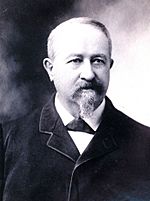Clarence Dutton facts for kids
Quick facts for kids
Clarence Dutton
|
|
|---|---|

Clarence Dutton
|
|
| Born | May 15, 1841 |
| Died | January 4, 1912 (aged 70) |
| Nationality | United States |
| Alma mater | Yale College |
| Known for | Isostasy, Grand Canyon geology |
| Scientific career | |
| Fields | Geology |
Clarence Edward Dutton (born May 15, 1841 – died January 4, 1912) was an important American geologist and a US Army officer. He was born in Wallingford, Connecticut. Dutton studied at Yale College. He later joined the army and fought in several battles. After his military service, he became a leading figure in understanding the Earth's geology.
Contents
Clarence Dutton: Geologist and Explorer
Clarence Dutton made big contributions to how we understand the Earth. He was known for his detailed studies of landscapes. He also helped explain how the Earth's crust balances itself.
Early Life and Army Service
Clarence Dutton was born in Connecticut in 1841. He went to Yale College and finished his studies in 1860. He continued learning there until 1862. That year, he joined the 21st Connecticut Volunteer Infantry. He fought in important battles like Fredericksburg and Nashville. In 1871, he was chosen to be a member of the American Philosophical Society.
Exploring the American West
In 1875, Dutton started working as a geologist for John Wesley Powell. Later, he joined the U.S. Geological Survey (USGS) in 1879. He mostly worked in the Colorado Plateau region. This area includes places like the Grand Canyon and the high plateaus of Utah.
Dutton wrote several important reports about these areas. His work helped us understand the geology of the Grand Canyon district. He also studied volcanic geology in places like Hawaii, California, and Oregon. He even helped coordinate the scientific response to a large earthquake in Mexico in 1887.
Measuring Crater Lake
In 1886, Dutton led a USGS team to Crater Lake, Oregon. This was a very challenging expedition. His team carried a special survey boat, named the Cleetwood. They had to carry this half-ton boat up a steep mountain slope. Then, they carefully lowered it 2,000 feet (610 m) into the lake.
From the Cleetwood, Dutton used piano wire with lead weights. He measured the lake's depth at 168 different spots. His team found the lake was about 1,996 feet (608 m) deep. Today, we know the deepest part is 1,943 feet (592 m), measured by sonar. This expedition was a great example of his dedication to science.
Understanding Earth's Balance: Isostasy
Clarence Dutton is famous for coining the term "isostasy" in 1882. This word describes a very important idea in geology. He explained that the Earth's crust is like blocks floating on a softer layer below.
He realized that different parts of the crust have different weights. Lighter blocks tend to float higher, forming mountains. Heavier blocks sink lower. This creates a general balance within the Earth's crust. He formally proposed the term "isostasy" in 1892. This idea helps us understand why some areas are high (like mountains) and others are low (like ocean basins).
A Gift for Describing Nature
Dutton was not just a scientist; he was also a talented writer. He had a special way of describing the geology and scenery he saw. He is especially remembered for his colorful descriptions of the Grand Canyon region in Arizona.
His writing helped people see the beauty and wonder of these places. One writer, Wallace Stegner, said that Dutton "first taught the world to look at that country and see it as it was." His words made the Grand Canyon come alive for many readers.
Later Life and Legacy
In 1891, Dutton left the USGS. He served as commander of the arsenal in San Antonio, Texas. He also worked as an ordnance officer. After retiring from the Army in 1901, he returned to studying geology. Clarence Dutton spent his final years at his son's home in Englewood, New Jersey. He passed away in 1912. His work continues to be important for geologists today.
Notable Publications
- 1880, Report on the Geology of the High Plateaus of Utah.
- 1882, Tertiary History of the Grand Canyon District.
- 1884, Hawaiian Volcanoes.
- 1889, The Charleston Earthquake of August 31, 1886.
- 1889, On Some of the Greater Problems of Physical Geology. This paper proposed the new term isostasy.
- 1904, Earthquakes, in the light of the new seismology

